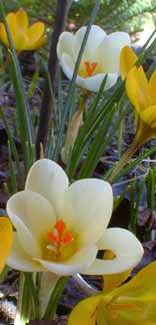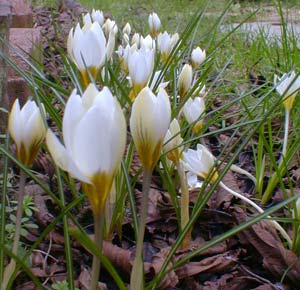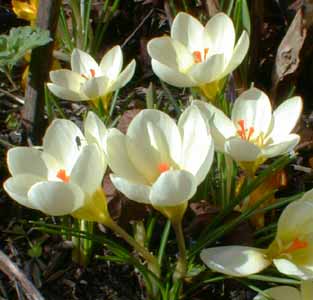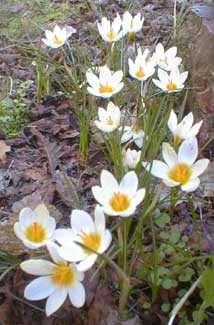
'Snow Bunting'
White Snow Crocus
"If frozen snowdrops feel as yet the sun
And crocus fires are kindling one by one:
Sing, robin, sing;
I still am sore in doubt concerning Spring."
-Christina Rosetti,
The First Day of Spring
The First Day of Spring
 A very few & random 'Snow Bunting' crocuses appear late each winter among the arrays of Snow Crocuses that have naturalized under & around the Oyama magnolia. This area has had several intermingling crocus cultivars spreading themselves out for several years.
A very few & random 'Snow Bunting' crocuses appear late each winter among the arrays of Snow Crocuses that have naturalized under & around the Oyama magnolia. This area has had several intermingling crocus cultivars spreading themselves out for several years.This variety of Crocus chrysanthus is named for the bird Plectrophenax nivalis, a sparrow that is not only largely white-feathered, but is prone to remaining in neighborhoods even through the winter, lives as far north as Iceland & Greenland, & throughout its range is a common sight hopping upon the snow.
In some places the snow buntings fly down to sea level from their mountain breeding areas, arriving in coastal towns in great numbers as early as November, & lingering until January or February, or about the same time the snow crocuses are in bloom.
 The Snow Bunting Crocus is an heirloom introduced to gardening in 1914, & was a recipient of the Royal Horticultural Society's Award of Garden Merit in 1993.
The Snow Bunting Crocus is an heirloom introduced to gardening in 1914, & was a recipient of the Royal Horticultural Society's Award of Garden Merit in 1993.It is often described as pure white, but close inspection reveals color. The ivory petals have the faintest ice-blue feathering on the outside darkening at the very base, plus a dab of faded orange deep in the center, together with its bright yellow-orange anthers.
 If you put your nose right in one of the Snow Bunting flowers, it is possible to detect a faint pleasant musk. In some gardens they appear as early as January, but in ours, the blossoms are up well before mid-February & if no hard rain batters them down prematurely they'll linger into March.
If you put your nose right in one of the Snow Bunting flowers, it is possible to detect a faint pleasant musk. In some gardens they appear as early as January, but in ours, the blossoms are up well before mid-February & if no hard rain batters them down prematurely they'll linger into March.Though Snow Crocuses are in general regarded as the first of the spring bulbs, they would be more accurately regarded late winter bloomers. 'Snow Bunting' is neither the first nor the last. In its immediate vicinity under the Oyama magnolia, the bright yellow crocus 'Goldilocks' is a week earlier, & the white & purple 'Prince Claus' a week later, all of them overlapping in bloom times.
While many of the snow crocuses long-naturalized in our yard have multipled like crazy, 'Snow Bunting' only has a few blossoms mixed about. Perhaps there were never but a few planted, therefore it remains scarcest in the array, but it is not a purely botanical C. chrystanthus being occasionally listed as C. vernus or C. x hybridis, & such hybrids typically do not naturalize as dramatically.
The first & third February photos are of 'Snowbuntings' in the old mixed drifts. Because we wanted more of the white ones, in Autumn 2004, for the sake of a pure 'Snow Bunting' drift, we planted thirty new bulbs in another yard, inside the dripline of a Dawn Viburnum, where lawn turf thinly extends. These were in full fat bud before January's end (2005) & shown in the second photo on an overcast day, February 1st, & in the final photo at the end of the first week in February (2006).
For this latter drift I had selected a location under deciduous bushes where I thought they'd have plenty of sunlight given that they bloom before spring leaves are returning to the shrubs. But on the ideal sunny day sun reaches them only around noon, so the location is less than ideal. Though I've not been inclined to move them, I have resisted planting further varieties of crocus in that part of the garden, since they only display themselves at their best while touched by sunlight.